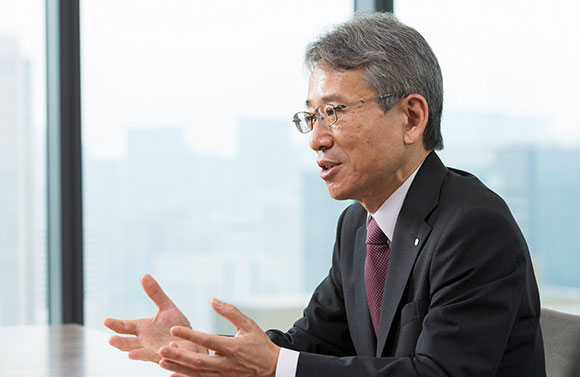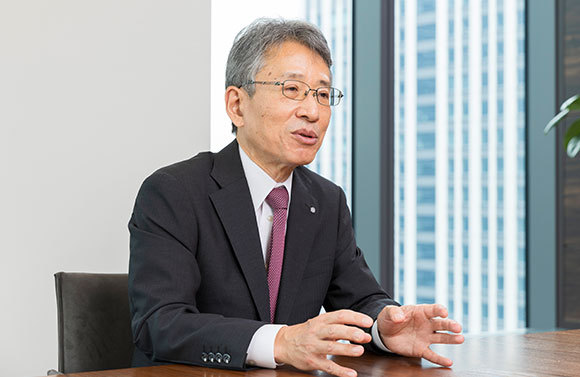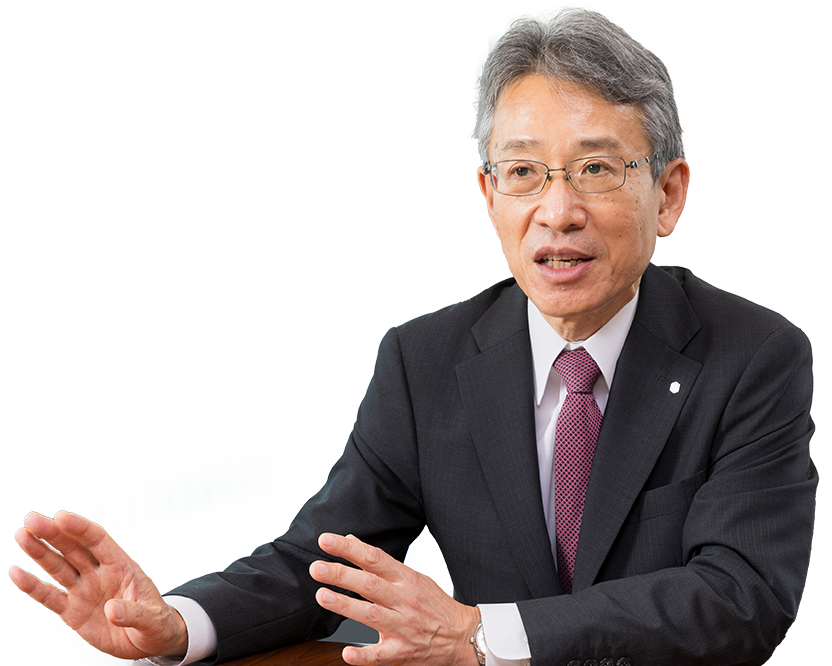Message from the Representative Director, Senior Managing Executive Officer (2023)
The Group has conceived of many products over its history. Please tell us about the source of the seeds for creating these products, and the process up to commercialization.
When looking at the source of outstanding seeds, we see that these necessarily arise from our Technological Platforms. Yet nurturing business to any significant degree is difficult without taking a seeds-out approach based on an awareness of markets. We therefore create products of value through the process of first selecting seeds from among our Technological Platforms, and then advancing commercialization with an awareness of markets. For example, although our perovskite solar cells are based on the sealing and coating technologies from our Technological Platforms, we are advancing their commercialization through an approach in which we first fully work out the potential for commercialization internally, and then move on to emphasizing the unique durability and productivity offered by the Group as a form of added value.
How do you allocate the different functions and roles between the New Business Development Department and the R&D Center?
To begin with, the R&D Center plays the roles of initially exploring and planning themes, and of establishing the basic technologies. In numerical terms, the R&D Center is responsible for moving a theme from a state of 0 to 1. In contrast, the New Business Development Department undertakes the role of business development, in other words of moving a theme from 1 to 10. After achieving 10 through business development, each divisional company takes responsibility for advancing the theme up to 100. The biorefinery business, for example, is only just now in the business development phase of moving from 1 to 10.
Before the establishment of the New Business Development Department in fiscal 2019, the R&D Department was entirely responsible for moving themes from 0 to 10. Because the required skills and given missions of R&D and business development differ, however, I feel that the current promotion system now allows the respective organizations to more reliably carry out their functions under a clearly defined division of labor.
When it comes to internal and external fusion, what kinds of initiatives are you taking in terms of technology exploration and new business development?
Under the previous Medium-term Management Plan, we prepared a Strategic Area Map that serves as a compass for exploring new businesses in specific areas. Based on this Strategic Area Map, we have formed teams within the Business Strategy Department that engage in open innovation and execute investments in venture companies in an effort to actively access external technologies and knowledge. Moreover, in regard to research themes, we are ramping up efforts that transfer research team members between divisional companies or between the divisional companies and the Headquarters. For example, material informatics, cell culture materials, and other themes that had been under the purview of the High Performance Plastics Company have been transferred to the R&D Center, which now allows us to advance R&D from a Group-wide perspective. Along with enhancing our ability to judge external technologies and knowledge, as well as the venture companies that possess these, I believe that further refining the outstanding R&D capabilities held by the Group is the key to initiatives for accelerating fusion.
In advancing commercialization, how do you select promising themes and manage their progress?
In terms of selecting themes, we apply a score along a market axis for judging the potential of the market and a strategic axis for judging how the technologies, patents, and human resources possessed by the Group can be effectively employed. We then focus our resources on themes that have received high scores along both of these axes. Once we have selected a theme, we continue to manage it by periodically analyzing the potential of the market and the competitive environment, and screen it to determine if our aggressiveness has abated. At the same time, we take the option of terminating any theme for which the score has fallen. In terms of actual progress management, we proceed towards commercialization upon implementing a five-stage Gate Review.
Please tells us about the ideal promotion system for new business creation, commercialization, and achieving profitability. In addition, what types of human resources do you see as important for this system?
By breaking down the phases following theme creation from 0 to 1, 1 to 10, and 10 to 100, I believe the current promotion system functions extremely well, whereas the one element that I feel is similarly central to each phase is human resources with a business perspective. Business perspective here refers to the sense that allows individuals to approach themes from both a technology axis and a market axis. Which is why we intend to apply the challenge of commercialization as a means of fostering a business perspective among those of the Group's human resources who are responsible for our diverse range of technologies. In fiscal 2023 we launched the in-house entrepreneurial system as a mechanism for assisting in the commercialization of business concepts presented by employees. Since this time, we have received nearly 200 submissions, far above the initial target of 100 submissions. I therefore feel we are on the right path since so many of our human resources possess an awareness of and think about commercialization. A business perspective can also be fostered through the process of attempting to manifest ideas into businesses, which is why this type of human resources platform is also important for creating new businesses in the future. And even if an idea fails to commercialize, I believe the very fact that more and more of our human resources are seriously considering and engaging in commercialization will also serve to strengthen the foundation for creating new businesses.
What kinds of discussions have the Board of Directors held in regard to creating new businesses?
The Board of Directors holds discussions on R&D at least twice a year, and receives progress reports on and confirms the direction of perovskite, biorefineries, and other critical themes undertaken across the Group once a year. Although the Board debates the potential for business from a highly critical perspective, it generally takes a supportive stance in regard to new challenges, which I feel has helped arrange a system that provides across-the-board support for new business creation.
We would next like to ask you about the seven major themes targeting commercialization over the medium term on an individual basis.

As far as entry into the aircraft field is concerned, the Group acquired AIM Aerospace Corporation in 2019, at which point we determined to fully enter the aeronautical fields. Despite a dramatic decline in aircraft demand during the COVID-19 pandemic, the market is currently showing signs of a gradual recovery. So, we will move full-ahead to realize the initial goals of this M&A under the Medium-term Management Plan. Based on our processing technologies, a strength of the Group, we will apply our lightweight CFRP (a lightweight, high-strength material) in an effort to expand the aircraft, drone, and other flight vehicle businesses. As a new foothold for entering air mobility markets, in March 2023 we also invested in Volocopter GmbH of Germany, an eVTOL (electric vertical take-off and landing) aircraft company. We will continue to develop this business so that we can serve as a reliable partner in the aeronautical fields.
From a next-generation communication components field perspective, we will evolve towards 5G, 6G, and other forms of high-capacity, high-speed communications. When properly installed in enclosed, indoor spaces, our Transparent and Flexible Radio Wave Reflection Film, which emerged from the Group's corporate venture capital efforts, is useful in fully exploiting the performance of communications with high directional stability within that space. With radio wave environment design services in our sights, we are leveraging the competitive strength possessed by our reflection films to promote business expansion, as well as to solve problems involved in establishing 5G and 6G environments, as a reliable partner for communications-related companies.
Turning to smart city strategies, in recent years we have employed our strengths in the Housing Business to promote town and community development that brings together knowledge from the Group and beyond. Currently, we are engaged in more than 20 town and community development projects around Japan. The energy self-sufficiency, SMART & RESILIENCE (safe, secure, sustainable), and other town and community development efforts that we have promoted to date have been well received for the sense of security they provide customers who have purchased them. Based on the concept of cities in which people can live with peace of mind, we will leverage the full power of SEKISUI CHEMICAL Group and combine our various businesses to deploy smart city strategies that further enhance security, health, comfort, and convenience as a means of further developing cities. Through fusion with the Innovative Mobility domain, for example, we will further improve convenience via the fusion of cars and homes. Similarly, by strengthening fusion with the Life Science domain, we will promote town and community development that considers health, in addition to convenience and peace of mind, so as to make living easier for the elderly.
In the Advanced Lifeline domain, we will engage in Overseas development of infrastructure materials. We will employ our SPR pipeline renewal system, FFU synthetic railway sleepers, polyethylene pipes, and other products that we have promoted in Japan to date in an effort to contribute to more resilient infrastructure around the globe, all while capturing renewal demand for infrastructure on overseas markets into the future. Already, we are starting to establish a business based on renewal demand for railway sleepers with a focus on Europe and the US, and are capturing renewal demand for sewage pipes overseas in regard to SPR. We have also discovered many business opportunities for industrial piping materials relating to semiconductor plants scheduled to begin construction overseas. And we have brought M&As with local overseas companies into our sights while working to increase the share of the Advanced Lifeline domain accounted for by overseas sales. Regulations and characteristics differ by country, however, so we plan to compete on the strength of our materials rather than expanding into construction and engineering projects.
In the new area of pharmaceutical CDMO domain, based on the relationships of trust we have built with pharmaceutical companies through our existing CMO (API Contract Manufacturing Organization) business, we will work to shift to a business approach in which we enter as a partner from the initial stages of new drug development by pharmaceutical companies as we establish the foundation for D (development). We will arrange the foundation for D through the synthesis of low molecular compounds, for example, and combine this technology with our strengths to form a foothold for entering high-value-added pharmaceuticals fields, such as medium molecular compounds and high molecular compounds. In fact, we already possess the synthesis technologies for peptides in the field of medium molecular compounds. Meanwhile, in the field of high molecular compounds, UK-based Sekisui Diagnostics possesses protein synthesis technologies. With these technologies as a strength, we will increase production capacity for APIs and intermediates for small molecule drugs as we advance our conversion to a CDMO for materials used in protein drugs. Moreover, in the regenerative medicine field beyond, we will leverage our technologies in an effort to promote regenerative medicine and to reduce costs. Specifically, we will enter the regenerative medicine field by enabling the development of cell culture materials from conventional animal sources as well as from chemical materials. Our first approach will be based on materials such as chemically synthesized scaffolding, and will rely on their ability to help reduce costs and stabilize quality.
Our efforts to develop perovskite solar cells have currently achieved a power generation efficiency of 15%, which is approaching the 18 to 20% level of silicon solar cells. The features of our solar cells are a durability of approximately 10 years when installed outdoors and high-productivity based on a roll-to-roll production process that is currently applicable to 30 cm widths. Our preparations for commercialization will be nearly complete, however, once we achieve a power generation efficiency on the level of silicon solar cells, a durability of approximately 15 years, and ultimately a roll-toroll production process for one-meter-wide cells. Our greatest area of skill is our ability to reliably produce perovskite materials and supply them to our partners. Certain placements also require unique construction and installation methods, however, so along with enhancing the performance of perovskite, we also feel it is important to find partners who are highly skilled in power generation related construction and installation to develop the necessary construction and installation methods.
As far as biorefineries are concerned, we are currently advancing initiatives for stable operations, cost reductions, and efficient production at a 1/10th scale demonstration plant. After completing the verification test phase during the current Medium-term Management Plan, we will enter the commercial operations phase during the next Medium-term Management Plan. The business model that we are currently considering takes a joint partnership approach with companies that manage waste disposal facilities and industrial waste treatment facilities, and constructs an ethanol facility next to the waste disposal facility of the partner to convert the waste from the waste disposal facility into ethanol. As a concept that replaces the existing approach of incinerating waste and releasing greenhouse gases with one that circulates resources by converting waste in its entirety into ethanol, we believe this process also offers significant value from an environmental perspective. Which is why we plan to sell the ethanol under a brand name. Like perovskite solar cells, biorefineries also rely on cooperation and fusion with external partners.
Please tell us about your roles as the Managing Director of the New Business Development Department, and about the challenges you face as Senior Managing Executive Officer.

My role as the Managing Director of the New Business Development Department is clear. Specifically, it is my duty to engage in business development that steadily commercializes biorefineries, perovskite, and the other major themes.
Despite being promising from both a strategic axis and a market axis, during the business development process for these themes we have often struggled with challenging issues. So, I believe a system in which the Board of Directors and management offers up the entire Group in support of our efforts is a critical factor in growing these themes into major businesses. On the other hand, that business development will not always proceed smoothly is only natural, which is why we must also foster a culture in which failures are not condemned and bad news is the first to be reported so that inconvenient information does not lie dormant below the surface. And a major challenge for myself is ensuring an organizational structure that seamlessly cycles through a process whereby all team members make every effort to find solutions in order to overcome issues as they are discovered. My most important mission is commercializing these seven major themes. Just as the so-called Seven Samurai innovators played a major role at the time of the Group’s founding, I intend to foster a culture of innovation within the Group that revives this heritage through the in-house entrepreneurial system.

